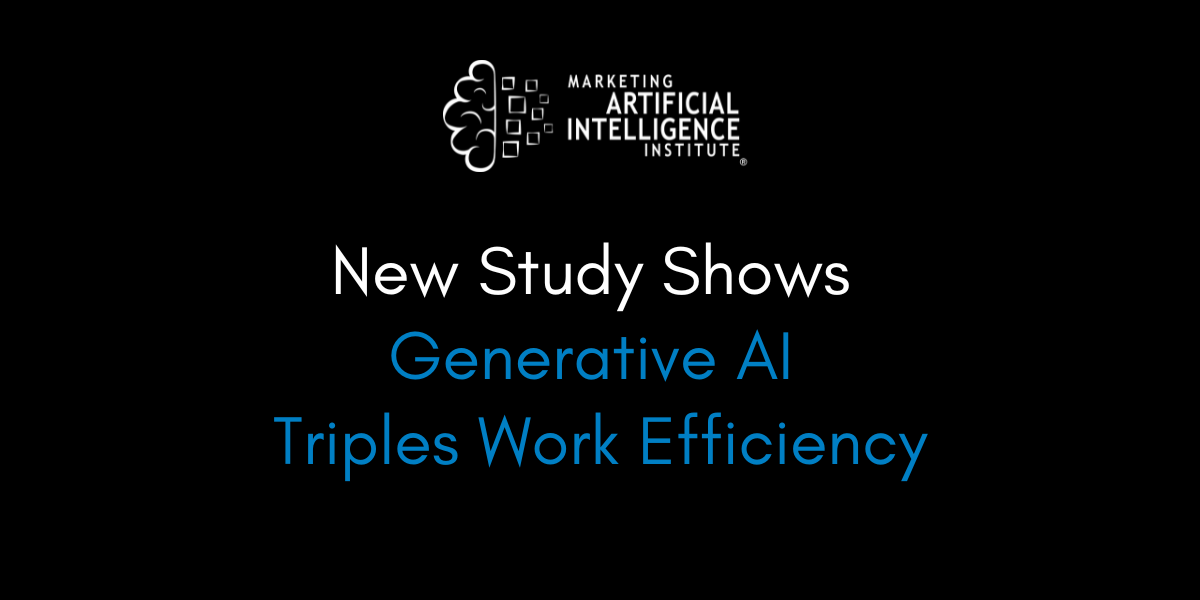A brand-new study shows that generative AI usage in the workplace is not only on the rise—it’s saving serious time on everyday tasks.
The study, led by Jonathan Hartley at Stanford University in collaboration with researchers from George Mason University, Columbia University, and the World Bank, surveyed more than 4,000 workers across the United States.
Their big finding? As of December 2024, 30.1% of respondents say they’ve used generative AI at work. That’s a major boost in AI’s workplace presence—and this surge in usage comes with a threefold jump in task efficiency.
But the real shocker? Despite these gains, the technology is still being used for only a fraction of the workweek.
To break down the research—and what it might mean for the future of work—I spoke with Marketing AI Institute founder and CEO Paul Roetzer on Episode 136 of The Artificial Intelligence Show.
Key Takeaways from the Study
Before we dive into what the study means, first here are some of the key takeaways that the researchers found:
- AI Use Is Growing—Fast
The survey confirms that AI adoption has shot up. More than 30% of workers surveyed have used generative AI on the job. That tracks with other research, but it’s still a leap from just a couple of years ago, when AI was relegated to more niche use cases. - Adoption Isn’t Evenly Spread
Younger, more educated, and higher-income workers are the ones most likely to rely on AI in their day-to-day work. Unsurprisingly, industries like customer service, marketing, and IT are the biggest adopters. By contrast, areas like agriculture and government lag behind significantly. - It’s Slashing Task Times
According to the study, tasks that used to take 90 minutes now take just 30 minutes using AI—a threefold efficiency boost. But here’s the catch: most employees integrate AI for less than 15 hours a week, so it’s still more of a powerful sidekick than a full-time partner. - AI Is Shaping Job Searches, Too
Over 50% of unemployed respondents who have looked for work in the last two years reported using AI for resumes, cover letters, and interview prep. That signals AI’s growing influence not just on how we do work—but on how we find it.
Why Recent Data Matters So Much
One reason this research is especially valuable? It’s fresh.
The data comes from December 2024, making it one of the more up-to-date looks at how AI is reshaping work right now. Roetzer points out that many AI studies rely on older data—often six months (or a whole “generation” of models) behind.
This study, however, gives a far more current snapshot of AI’s real-world use that’s more reflective of the tools we have today.
He does caution, however, that not all numbers line up neatly across different reports.
Microsoft and LinkedIn once released a study suggesting 75% of workers used generative AI—an estimate he found high. This new study’s 30% figure, Roetzer says, seems more realistic, thanks to a broader sampling of industries.
A Glimpse Into the Near Future
So, does tripling productivity mean we’re done adopting AI?
Not even close.
Roetzer notes that we’re still “trying to figure out” how advanced these models can get and how quickly they’ll scale. With more powerful models from big players like Anthropic, OpenAI, and others on the horizon, we could see a jump from that 30.1% adoption to an even broader segment of the workforce.
And that means leaders should pay attention—whether they’re in government, business, or academia.
Even if we halted AI progress today, a 3X efficiency bump is no small thing. Tasks that used to chew through 90 minutes of your day are now done in 30. Multiply that across an entire organization, and it’s a massive shift in how quickly—and cheaply—things get done.
He also points out that as AI gets better, we’ll likely see more tasks that can be completed without human involvement at all—and that has ripple effects for the structure of jobs, the economy, and the skill sets workers need.
“I don’t think people realize how many of the tasks we do—were within 12 months of AI doing them at or above average human level," says Roetzer.
What It Means for Leaders and Teams
For business leaders: Pay attention. This isn’t a hypothetical scenario—generative AI is making work faster today, particularly for employees with higher education and income. If you’re not already exploring how AI can streamline tasks in your organization, you could quickly fall behind.
For policymakers: The future isn’t 10 years down the road; it’s next year. AI could soon handle more tasks at above-human levels, and that means regulators and legislators need to prepare for real changes in how people work.
For universities and job-seekers: Skills in using AI tools—whether for actual project tasks or for job hunting—are already giving certain candidates an edge. That edge is likely to sharpen as adoption grows.
The Bottom Line
This study offers a crucial reality check on where generative AI stands in the workplace today—and a taste of what’s possible tomorrow.
AI usage is no longer limited to tech types and early adopters; it’s moving into marketing departments, contact centers, and IT teams nationwide.
While we’re only scratching the surface of AI’s full potential, the numbers here are clear: in many cases, generative AI is already making people three times more efficient.
So, if a 3X productivity boost sounds good to you—or like a scary inevitability—buckle up. It’s only going to accelerate from here.
Mike Kaput
As Chief Content Officer, Mike Kaput uses content marketing, marketing strategy, and marketing technology to grow and scale traffic, leads, and revenue for Marketing AI Institute. Mike is the co-author of Marketing Artificial Intelligence: AI, Marketing and the Future of Business (Matt Holt Books, 2022). See Mike's full bio.



